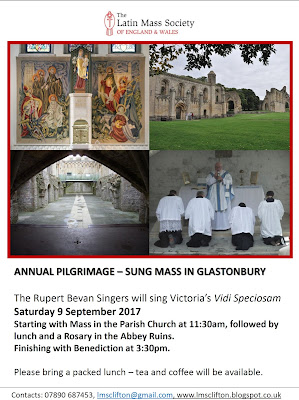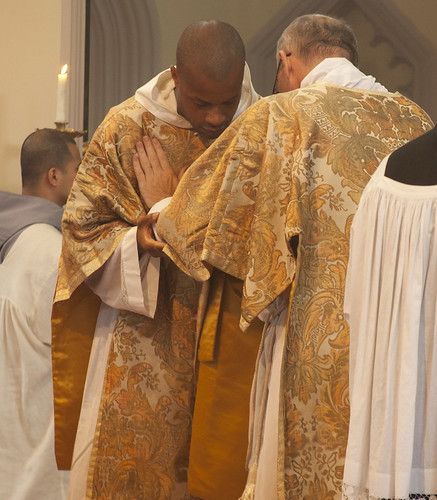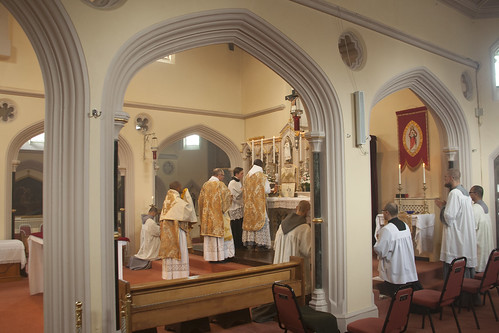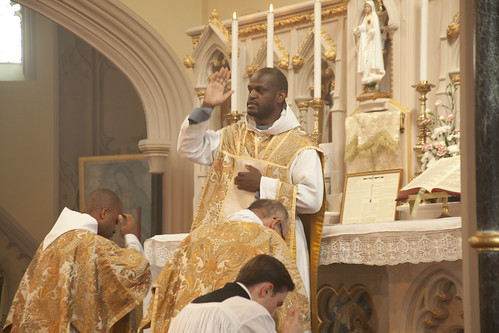Chairman's Blog
What's wrong with Yoga? Part 1
 |
| Physical Culture: from Wikipedia Commons |
I have been doing a bit of thinking and reading about the New Age, and a talk at the Roman Forum in Gardone this year stimulated me to do more of each about the phenomenon of Yoga: a talk by the Swedish academic Clemens Cavellin, which is available on his website here.
Yoga is one of those hot-button issues which arouses strong feelings in Catholic social media, and as much of the discussion is not very well informed, I thought I'd try to inform it a little.
Before my full assimilation into traddie-land I did a bit of Yoga myself for a few years; accordingly I have my own impressions of the general atmosphere and attitudes of Yoga classes, books, and personal practice. However it must be said that my experience was fairly superficial; I never entered any inner circle of Yoga adepts. The spiritual aspects of Yoga was part of the reason I stopped: I got fed up with being told to say 'Om', for example. Another was doubts about its physical efficacy. I don't deny the health benefits, but there is a natural tendency in Yoga to want to advance to the more perfect performance of more difficult postures, and, in short, become really really bendy, and while being a bit bendy is probably a good idea, I don't think it is particularly beneficial to be really really bendy. However, I'm not qualified to comment further on that.
In this post I want to talk about the philosophico/religious presuppositions of Yoga, or rather why it is so difficult to talk about such presuppositions. Having cleared this ground, in the next post I'll say what I think can be said about Yoga as a phenomenon, and its relationship with the Catholic Faith.
Yoga is typically characterised as a set of physical practices, of ancient origin, associated with Hinduism. This needs to be qualified in a number of ways.
First, we need to distinguish 'physical' Yoga from way the term 'yoga' is used in ancient Indian texts. The term is in fact extremely broad; it can refer to any kind of practice or technique (and various other things). From now one I'll take for granted that we are talking about 'postural' Yoga unless I specify otherwise.
Secondly, a distinction between Yoga as we know it today and pre-modern (pre-20th century) Yoga, insofar as it is useful to talk about pre-modern 'Yoga'. The money quote is this (from Andrea Jain Selling Yoga):
In other words, today’s popularized yoga systems are new, not continuations of some static premodern yoga tradition from which practitioners and nonpractitioners alike often claim they originate. Even postures and breathing exercises were marginal to the most widely cited sources on yoga prior to the twentieth century, and the forms of postures and breathing exercises that were present in those sources dramatically differ from those idiosyncratic forms found in postural yoga today.
Jain cites many academic sources on this topic and goes into some detail about what kinds of postures are mentioned in pre-20th century texts: basically, just sitting still and comfortably for prolonged meditation; and what kind of breathing exercises they mention: basically, holding the breath, in or out, for periods of time. Anyone bamboozled by talk of the 'Yoga Sutras' and other ancient texts or artifacts should read her book. In a word, the claim that Yoga as practiced today has ancient origins, except in the loosest possible sense, is completely false.
Thirdly, ancient and modern Yoga alike (acknowledging that they are two completely distinct things) are not the property of Hinduism. Ancient Yoga is found in the context of the Jain religion, Islamic Sufism, and Buddhism, as well as Hinduism, the last being itself a vastly complex collection of religious beliefs and practices and philosophical ideas. Modern Yoga is found in the context not only of Hinduism, but versions have been developed and promoted by a Jain sect, and obviously also by every imaginable shade of syncretist, secularist, and even Christian guru or organisation.
The question is complicated by the fact that some Hindu groups in India would like to appropriate ('authentic') Yoga as their possession, and minority religious groups have responded in kind, by resisting, for example, the inclusion of Yoga as a compulsory school subject in Indian schools. The limited historical connection between modern Yoga and Hinduism does not mean that Yoga cannot become a badge of identity for Hinduism in certain contexts.
So, where does modern, postural, Yoga come from? It derives from a serendipitous meeting of Hindu nationalism with the early 20th century European/English speaking physical culture movement. All the stuff about exercising by bending and stretching in unison comes from Western sources. Just do an image search for 'physical culture' and you'll find lots of black-and-white photos of (mostly female) fit-looking individuals in taxing-looking poses in sync, from the 1930s; the one above is an early example, dated 1913. If it looks a little fascistic, obviously the fascists thought this stuff was great, but you didn't need to be a fascist to do it. It was picked up by Hindu nationalists in the 1940s, who connected it with Hindu spirituality and the concept of 'yoga'. This then re-entered the West in time for a craze for Eastern wisdom connected with the New Age movement, in the 1960s. (This, essentially, is the thesis of Jain's book.)
Now obviously anyone can pick up where the physical culture movement left off, but the spirituality and philosophy of its Indian incubation has had an impact on what Yoga is all about. The trouble is that this spirituality and philosophy is extremely complex, and movements and individuals can evolve and be as syncretistic as they wish.
There is a basic distinction which needs to be made in Indian thinking, between dualistic and non-dualistic approaches. By Dualism is meant a distinction between the body and the spirit, which leads to asceticism as a route for the spirit to subdue and ultimately escape the body and the physical world. Non-dualistic views, which can be pantheistic, see this distinction as itself an illusion, so are more open to the idea of using the body in spiritual exercises. Now, it is possible to see postural yoga as an ascetic exercise, along with a vegetarian diet and celibacy; confusingly, it is also possible to use postural yoga on the basis of a non-dualist philosophy, the most famous manifestation of which is Tantra. Everyone knows Tantra's connection with sex: not only does some Tantric practices promise greater sexual performance, but sex itself can be a practice of deliberate norm-violation to free oneself from false ideas about the distinction between the body and the spirit.
Different strands of Yoga can in principle be lined up with this distinction. The Jain religion is firmly dualistic, and one Jain sect has developed and marketed a version of Yoga. On the other hand, Bikram Choudhury, founder of Bikram Yoga, ended up in a scandal about inappropriate relationships with female devotees, something connected with the interest he developed, as his career progressed, in Tantra; something similar happened to John Friend, founder of Anusara Yoga. Tantric theory is a bit like Freudianism, in giving support - real or imagined - to some unfortunate personal choices.
Having made this distinction, one has to ask whether it makes any difference to the experience of Westerners going to a yoga class. The philosophical views of the class teacher, or the school in which the teacher trained, may make some difference to the way he or she goes about the task of teaching Yoga, but most of the people in the class are there for the goals of physical health, beauty, and fitness. The titillating possibility of enhanced sexual powers is a nice touch of course, but you can spend a lot of time doing Yoga without that coming up.
Given Yoga's debt to early 20th century Western ideas about physical culture, and given its extremely successful adaptation to the modern interest in fitness and beauty, debates raging back in India about dualism and non-dualism seem of very slight importance. As I have described them neither view is compatible with the Catholic Faith, but then again you can find Yoga teachers with zero interest in any version of Indian religious and philosophical thought, and come to that you can find Catholic priests teaching Yoga.
So to conclude this first post of the two-part series, I think it is important to avoid trying to solve the problem of the relationship between Yoga and the Faith in too simplistic a way, by saying for example that Yoga is a body of ancient Hindu spiritual or even latreutic (worship) practices: it isn't. Nor does it have an indelible connection with any single set of philosophical views.
The problems with Yoga need to be approached in a more subtle way.
Support the work of the LMS by becoming an 'Anniversary Supporter'.
Epiphany and Ascension restored to their proper days
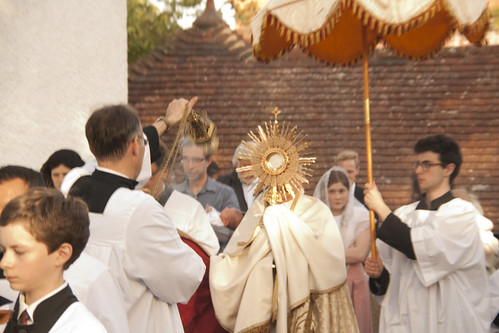 |
| Corpus Christi Procession in Oxford: on the correct day |
As I've noted before, the 2006 decision of the Bishops Conference of England and Wales to celebrate Ascension, Corpus Christi, and Epiphany onthe nearest Sunday in the Ordinary Form is the most unpopular one I can think of in my experience. Letters in the press and blog posts criticising it appear year after year. The few who defended the decision when it was first made long ago gave up trying to respond. It is good to see the bishops are big enough to recognise that they made a mistake, although it is also true that there has been a big turnover of the Conference in the last eight years, and ironically enough today's announcement is accompanied by the news of the death of Cardinal Cormac Murphy O'Connor, the architect of the original decison: requiscat in pace.
Here is the Bishops' Decree. We can now set our sights on restoring Corpus Christi to its proper date, and reversing the decision of 1984 to move the celebrations of all the Holy Days to Sunday when they fall on a Saturday or a Monday (except Christmas). At any rate, it seems we'll have a few more years to advertise the fact that if you want to attend Corpus Christi on its 'particular day' (as the CDW expresses it) you'll have to go to the Traditional Mass.
I've written about the importance of the precise dates here; about the importance of the obligation to attend Mass on these days here. There is a Position Paper on this subject here.
The wheels of the Church grind slowly indeed. The Bishops of England and Wales have been talking about reversing the 2006 decision since at least 2014. I see they made the decision on 17th November 2016, and that the Congregation for Divine Worship received their letter on 21st February. So it took them three months to compose and send the letter. It then too the CDW more than six months to reply, with the paragraph I past in below, simply to allow our bishops to revert, partially, to what is envisaged as the norm by Canon Law (Canon 1246). It then took nearly a whole month for the Bishops' Conference to release the letter from the CDW to the public.
I'm not complaining. I'm just awed.
CONGREGATION FOR DIVINE WORSHIP AND THE DISCIPLINE OF THE SACRAMENTS
Prot. No. 180/17
ENGLAND AND WALES
To His Eminence, Cardinal Vincent Nichols, Archbishop of Westminster, President of the Bishops’ Conference of England and Wales, having taken into consideration the letter received on 21st February 2017, by virtue of the faculty attributed to this Congregation by the Supreme Pontiff FRANCIS, we willingly grant that in future, in the calendar specific to the same Conference, the celebration of the solemnity of the Ascension of the Lord will be celebrated on its particular day, namely, forty days after Easter; the celebration of the Epiphany of the Lord on its particular day, namely, 6th January. When the solemnity of the Epiphany of the Lord falls on a Saturday, it is to be assigned to the Sunday following; when on a Monday, to the Sunday preceding. All things to the contrary notwithstanding. From the offices of the Congregation for Divine Worship and the Discipline of the Sacraments, 4th August 2017, on the feast of St John Mary Vianney, presbyter.
Robert Card. Sarah Prefect
+Arthur Roche Archbishop Secretary
Support the work of the LMS by becoming an 'Anniversary Supporter'.
Irreversible reform? Me in the Catholic Herald this weekend
This weekend the Catholic Herald has a cover story about the Traditional Mass' appeal to young people, by Matthew Schmitz.
Accompanying this is a shorter piece by me on Pope Francis' remarks, make in a speach to a group of Italian liturgists, that the 'reform' is 'irreversible'.
It is not available online, so you'll need to look out for a paper edition. Here's a taster.
Pope Francis’s recent address on the liturgy – about which he has hitherto said little – was striking for its conventionality. In almost every respect, the Pope’s speech hews to the official, post-Vatican II line. It emphasises the continuity of the post-conciliar reform with the efforts of Pius X and XII; it praises the reform for its “vitality”; it condemns liturgical abuses (“deformations”); and it calls for an end to liturgical conflict.
But it has raised eyebrows for its rejection of the possibility of revisiting the “decisions” of the reform in light of its “inspirational principles: an explicit rejection of the “Reform of the Reform” project, which seeks to go back to the Council documents and do the reform again, better. This should be no surprise. In the official mindset, the reform was perfect and was marred only by liturgical abuses. Liturgical progressives should note that the account of the liturgy which follows is entirely traditional, focusing on the altar, the Sacrifice of the Mass, and the Priesthood of Jesus Christ, not even mentioning the Last Supper, the Mass as a shared meal or the liturgy as an affirmation of community.
Pontifical Mass for the 10th Anniversary of Summorum Pontificum in London: 14th Sept
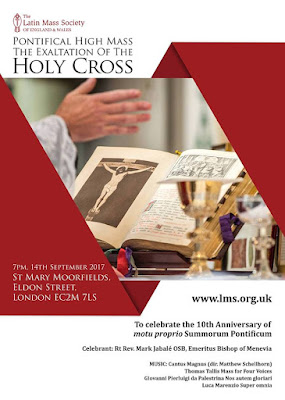 Thursday 14th September, 7pm: Pontifical High Mass in St Mary Moorfields, Eldon Street EC2M7LS
Thursday 14th September, 7pm: Pontifical High Mass in St Mary Moorfields, Eldon Street EC2M7LSTo celebrate the 10th Anniversary of Summorum Pontificum, celebrated by Rt. Rev Mark Jabale OSB, Emeritus Bishop of Menevia.
Music by Cantus Magnus directed by Matthew Schellhorn:
Thomas Tallis (c. 1505 – 1585) Mass for Four Voices
Giovanni Pierluigi da Palestrina (c. 1525 – 1594) Nos autem gloriari
Luca Marenzio (c. 1553 – 1599) Super omnia
Kyrie XI
Support the work of the LMS by becoming an 'Anniversary Supporter'.
Crying rooms in churches: a terrible idea
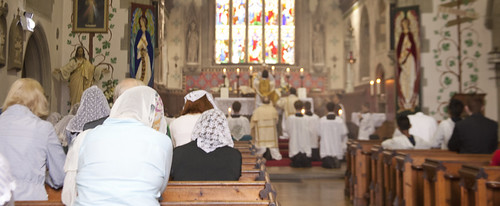 |
| Adults and children kneel for the Consecration at the St Catherine's Trust Summer School |
Last weekend's Catholic Herald carried an article by me about 'crying rooms', spaces sealed off with soundproof glass intended for noisy children and their parents.
I was inspired to write it by realising that the notion of excluding children from the rest of the congregation, or even from Mass entirely, was an idea with a following among not a few conservative and traditionally-minded Catholics. It is a reaction against the experience of chaotic liturgy where children are allowed to wander around, perhaps even into the sanctuary, which I suppose is more associated with a 'progressive' liturgical attitude. The thought would be: if we want a well-ordered, reverent liturgy, we need to get the small children under control; since we can't rely on parents to do this, we should bundle them into a separate space where they won't spoil things for everyone else.
This is short-sighted, however: as I explain the article, children won't learn to behave if shoved into a room where they can behave as badly as they like, and their parents won't learn to discipline them in that context either. Neither the parents nor the children will experience the atmosphere of the liturgy, and both are left with the impression that they are not truly welcome.
I have noted on this blog that another element in the anti-child mindset is the idea that children won't get anything out of the liturgy anyway because the liturgy has to be grasped intellecually in order to have any effect on the worshipper. This, of course, is absurd; indeed I fancy that few people who are influenced by this idea would actually agree with it when set out in black and white. But if it is false, then obviously children, and indeed infants, will benefit from the sacraments and blessings of the liturgy, which is of course why we get babies baptised.
Here's the beginning of the article.
To many people disturbed by children making a noise during Mass, “crying rooms” must seem like an answer to prayer. The children can just go in there, and the problem is solved.
Things look rather different from a parent’s perspective, however. If your noisy child goes into a crying room, with other noisy children, then you have to go as well, and quite probably your other children with you. The problem of the disturbance hasn’t actually been solved: it has been alleviated for most members of the congregation, and made much worse for others. If you haven’t had the incomparable experience of screaming babies in a confined space, you should try some long-haul flights in the holiday season.
Read it all there.
Support the work of the LMS by becoming an 'Anniversary Supporter'.
We're off to Walsingham!
This is a scheduled post: blogging from the road is very difficult. But please remember the Latin Mass Society pilgrims on the road to Walsingham, departing early Friday and arriving lunchtime on Sunday. After Mass in the Catholic Shrine, we walk the last, 'Holy Mile', to the site of the Medieval Shrine, arriving there at about 4:30pm, with many others who've come for the day.
Join us next year!
Support the work of the LMS by becoming an 'Anniversary Supporter'.
Moving Priests: Spetchley and Hethe
| Fr Anthony Talbot in the chapel at Spetchly Park |
Archbishop Longley is moving some priests around in his diocese, and this will effect the provision of the Extraordinary Form in two locations.
Fr Paul Lester is moving away from Holy Trinity, Hethe, and we wish the best in his new parish. He will be leaving on 10th September. It was entirely his initiative to start celebrating the Traditional Mass in the beautiful church of Holy Trinity, and to do so every Sunday, including most recently two Sung Masses a month, and the occasional High Mass with deacon and subdeacon. Among his other achievments as Parish Priest, Fr Lester arranged for Archbishop Longley to celebrate the EF in Holy Trinity, and celebrated Midnight Mass in the church each Christmas.
We are extremely grateful to him for all of this, which has been a tremendous benefit to many supporters of the EF in the area, and to many, indeed, who were able to discover it.
Fr Lester has been in Hethe only three years, but happily what he started will continue.
Fr Anthony Talbot will be moving away from Spetchley Park, where he has been chaplain in the private chapel there. His new role will include celebrating the Traditional Mass in Hethe.
It is a matter of regret that for the moment it would appear that regular Masses will no longer be taking place at Spetchley Park. However, we are very pleased that continuity of the EF at Hethe has been ensured, and I personally look forward to seeing Fr Talbot, a long-standing friend of Tradition, in Holy Trinity. We are very grateful to Archbishop Longley for bearing in mind the needs of the traditional faithful in Hethe, as he juggles his limited resources in his enormous diocese.
If there is a short gap between Fr Lester's departure and Fr Talbot's arrival in Hethe, the Latin Mass Society will do its best to arrange for the regular Sunday Masses at 12 noon to continue without a break.
Support the work of the LMS by becoming an 'Anniversary Supporter'.
Latin Mass Society Pilgrimage to Glasonbury 2017
The Latin Mass Society's annual Pilgrimage to Glastonbury will take place on Saturday 9th September.
It starts at 11:30am with Sung Mass in the Catholic Parish Church, St Mary's, Magdalene St, Glastonbury BA6 9EJ: click for a map.
This is directly opposite the ruins of the Abbey, and pilgrims will as usual have access to the Abbey grounds as part of the pilgrimage.
Support the work of the LMS by becoming an 'Anniversary Supporter'.
High Mass and Family Day at St Mary's Gosport
On Saturday 12th July I attended High Mass in St Mary's, Gosport, where the friars organised a 'family day', with some talks about matters of interest to Catholic families and activities for the children.
I gave a talk about the absence of men from the Church. But here are some photos of Mass.
The celebrant was Fr Pio, the deacon the Rev Stephen Morgan, and the subdeacon Fra Rosario.
Support the work of the LMS by becoming an 'Anniversary Supporter'.
Guild of St Clare: sewing workshops in Oxford
Well, strictly speaking these are in Headington, a suburb of Oxford. But everyone is welcome. Cross-posted from the Guild blog.
Forthcoming autumn events
2nd September: Project Finishing - bring along your unfinished sewing projects and make some progress with the help of our skilled Guild members!
21st October: Embroidery techniques with Jacqui McDonald of the Royal School of Needlework
11th November: Vestment mending and making - we have various altar furnishings, chasubles, and a cope in need of repair. Join us to assist us in mending them, learn about their construction and serve the Church.
All these workshops are taking place at St Anthony of Padua church hall, 115 Headley Way, Oxford OX3 7SS. They run between 10am and 4pm. Tea and cake is provided - please bring your own lunch. For more details or to book a place please email Lucy on lucyashaw@gmail.com.
Support the work of the LMS by becoming an 'Anniversary Supporter'.


